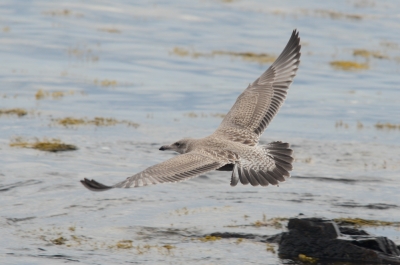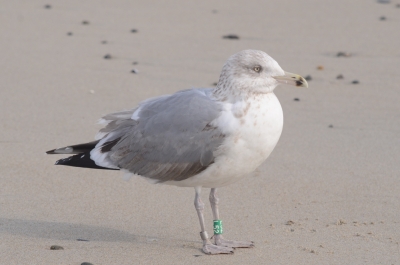Photo Essay: Herring Gull Plumages |
Immature gulls come in a bewildering variety of plumages, which makes them one of the most difficult identification problems faced by the average birder. A typical large gull takes four years to mature. These 4 years are usually divided into 4 plumage 'cycles:' first cycle is from fledging to its first birthday; second cycle is from first to second birthday; third cycle is from second to third birthday; and the fourth cycle ends in the spring of the bird's fourth year. During each cycle, the bird molts all its body feathers twice and all its remiges (flight and tail feathers) once. By the end of this process, the bird has a full set of adult feathers. It will molt and replace these feathers on the same schedule (twice a year for body feathers, once a year for remiges) for the rest of its life. Since the bird can't afford to ever be without a functional set of feathers, especially flight feathers, molting is a gradual process that takes place over several months. (For a more complete and technical explanation of the molting process and the terms used to describe it, refer to Gulls of the Americas, in the Peterson Reference Guide series.)

Herring Gull R77 in flight only a couple of weeks after first fledging.
Gulls of the Americas is only one of many sources, both in print and online, that attempt to illustrate and describe gull plumage cycles. So why this photo-essay? Simple. Neither Gulls of the Americas nor any other printed reference that I know of uses photographs of banded gulls -- and in particular, birds that were banded as chicks. One other website does, the Gull Research Organization's complex of pages on Larus argentatus smithsonianus, aka the American Herring Gull. About half their photos show banded birds. The advantage of using such birds is that we know, without a doubt, when the bird was banded and therefore how old it is. The Appledore Gull Banding Project on Appledore Island in the Isles of Shoals has banded hundreds of gulls over the last ten years. Since I started noticing and photographing banded gulls a couple of years ago, I've taken dozens of photos of Appledore-banded gulls, including many young ones at different ages. (For some reason, almost all of these have been Herring Gulls; I have only a few pictures of Appledore Great Black-backed Gulls.) As a result, my photos of Appledore Project gulls provide a chance to survey immature Herring Gulls and their plumages, all with gulls of known age.

Herring Gull L52, as it appeared late in its 3rd year of life.
What follows is my attempt to put this fact to use, using photos from my personal collection. This is NOT intended to be a thorough or complete study. Individual Herring Gulls vary greatly in their rate of maturation and in the timing and speed of their molt cycles. Rather, this is simply one journeyman birder's attempt to illustrate Herring Gull plumages using birds of known ages. Hopefully this photo-essay will help other birders learn how to tell an immature gull's age.
Use the gull-head icons at the top of each page to move forward (right-facing icon) and back (left-facing icon).